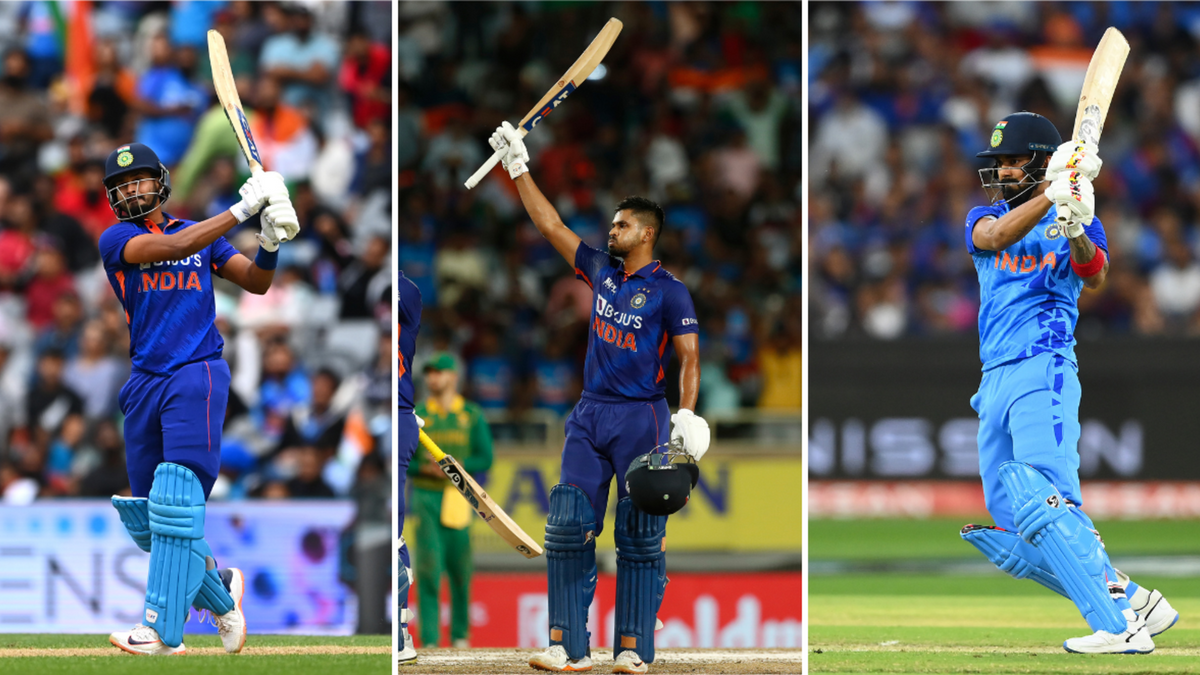
Nine months ahead of the 2023 World Cup on home soil, the Indian team faces an enviable problem of plenty in the middle order.
Let us start the discussion with the bowlers. The starting XI for India will feature six cricketers who can bowl. Hardik Pandya will certainly make it – as long as his fitness stays intact – along with two or three other fast bowlers, to be chosen from Jasprit Bumrah, Mohammed Shami, Mohammed Siraj, Umran Malik, and Prasidh Krishna.
There will be two or three spinners as well, at least one of whom will be Ravindra Jadeja and Axar Patel, with Washington Sundar and Shahbaz Ahmed as back-up. The other, Yuzvendra Chahal or Kuldeep Yadav.
In other words, India will go in with Pandya, a spin-bowling all-rounder (let us assume Jadeja), and four specialist bowlers. Unless one of the pacers is replaced by one of Shardul Thakur, Deepak Chahar, or Bhuvneshwar Kumar – unlikely , given India’s recent inclination towards pace in ODIs – the tail will start at No.8.
That leaves the top five. And none of the the likely candidates for these slots bowls enough to be considered as a sixth bowler. India will hence have to go in with five men who do not bowl and four men who are ordinary batters.
Thus, they have to play both Pandya and Jadeja. If they replace one with a specialist bowler, the tail will begin at seven. If they replace one with a specialist batter, they will be without a sixth bowler.
It is, thus, safe to conclude that India will go in with five batters. Since Rohit Sharma and Virat Kohli are more or less certainties, India will pick three more batters, at least one of whom can open batting, and at least one of whom can keep wicket.
Since his return to the ODI side in 2022, Shubman Gill averages 70.41 with a strike rate of 107. The performance has impressed the team management enough to overlook Shikhar Dhawan’s experience and Ishan Kishan’s double-hundred in Gill’s favour. Unless he drastically loses form, Gill is set to join Rohit and Kohli as part of a top three.
In essence, that leaves exactly two slots to be filled, Nos. 4 and 5 – and at least one of them needs to be a wicketkeeper. They have several options to choose from.
Shreyas Iyer
1,593 runs @ 46.85, strike rate 96
Iyer is, at this point, one of five batters in history with 1,500 runs, an average of 45, and a strike rate of 95 in ODI history. AB de Villiers, David Warner, Jonny Bairstow, and Quinton de Kock is illustrious company to be in. In all of 2022, he got out for a single-digit score only once.
What perhaps stands out is the lack of big scores: only two hundreds across 37 innings, but Iyer’s consistency has been enough for the team to back him at No.4 ahead of some others.
KL Rahul
1,863 runs @ 45.43, strike rate 87
The much-maligned Rahul had a torrid time in 2022, but his ODI record has stood the test of a bad year. Of the 10 batters with 500 runs between Nos. 4 and 6 at an average of 50, only de Villiers has scored at a rate quicker than Rahul’s (average 51.23, strike rate 98).
Perhaps it is the entry point – in the middle overs, where he can take some time before going for the shots – that has allows him to find his comfort zone in the ODI middle order. As with Iyer, India are backing him as of now, for No.5 as well as first-choice wicketkeeper. He comes with the added advantage of being an emergency opener.
Suryakumar Yadav
384 runs @ 32, strike rate 101
In a way, Yadav’s strength in Twenty20 cricket has perhaps turned out to be his weakness in ODIs. In New Zealand, he was caught at slip twice, a rarity in the shortest format but an often-used tactic against new batters in the middle overs in ODIs (he averages 36 even in List A cricket).
Unless he can dig deep, the only slots for him to bat at is probably at No.6 or lower, cutting loose in the death overs. For that role, India already have Pandya (average 33.39, strike rate 114).
Ishan Kishan
477 runs @ 53, strike rate 112
The numbers are boosted by that remarkable 131-ball 210 (they used to be 33.37 and 91 before that), but there is more to Kishan than that one onslaught. Kishan can adapt to different batting positions, and can pace his innings well in the middle overs before the final onslaught.
With Shikhar Dhawan seemingly out of contention, Kishan is also the only one who can break the monotony of right-handers in the Indian top order, while he will have an edge over the non-wicketkeepers.
Rishabh Pant
865 runs @ 34.60, strike rate 107
The numbers are superior to Yadav’s and pre-210 Kishan’s, while he is easily the best wicketkeeper of the available options. Since the start of 2021, Pant averages 44.63 at a strike rate of 109 – outstanding numbers by any standards. The car crash has pushed his career back by a few months, but if he recovers in time, the left-handed Pant will be the sternest rival for the current default choices, Rahul and Iyer.








